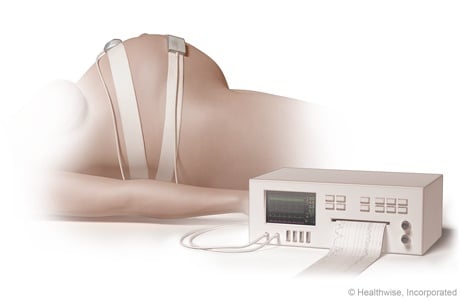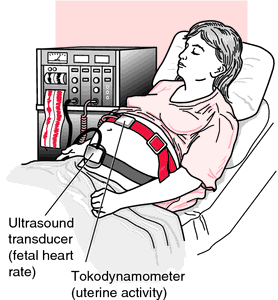If you are pregnant you may be considering having a contraction stress test. If so, you may be asking yourself questions such as what the procedure is like and how it feels? Well, we have you covered. Continue to read on for the answers.
What Is A Contraction Stress Test?
One of the most important points to remember about the test is that it is conducted to simulate labor and the contractions you have where the oxygen levels will decrease for your baby. This is the only way to test whether or not the unborn baby will be able to deal with the stress of “proper” labor, when contractions will be coming on a regular basis. You’re probably dreading this part the most, but bear in mind the end results – your baby in your arms.
If you are 34 or more weeks pregnant, it may have been suggested that you have a contraction stress test. The test monitors the heartbeat of your unborn baby externally.
During contractions, the oxygen and blood supply that is going to your unborn baby drops. However, in most circumstances there is generally no cause to be alarmed. For the majority of babies, this isn’t going to be an issue. On the other hand in, a small portion of babies, the rate of the heartbeat can slow down. This is where it is picked up by the monitor as it can become an issue in labor.
The test may last for as little as 10 minutes, but this may depend on your doctor and individual circumstances.
How to Prepare
Before you are due to take the contraction stress test you will be asked to prepare for it.
Here is what you should do:
- Avoid eating and drinking for between 4 to 8 hours.
- If you are a smoker, you will be asked not to have a cigarette at least 2 hours before you are due to have the test.
- You will have to sign a consent form stating that you know the risks of having the test done and you agree to those risks.
What Is the Procedure Like?
The procedure can be a bit of a worry to most women. However, it really shouldn’t be since the test is pain free and it is for the benefit of your baby.
Throughout the test you will be asked to lie down with your back raised up and tilted slightly to the left. This may be a bit uncomfortable, but you will just have to try and grin and bear it. Plus, it won’t last long.
An injection of the hormone Oxytocin will be given and you will have contractions. Strange, as it seems you may also be asked to massage one of your nipples since this will also start off the contractions.
Two belts will then be placed around your belly, with one of them holding down the sensor to record the heartbeat of your unborn baby, while the second measures contractions. The sensors are plugged into the recording unit, monitoring the heartbeat of the baby for about 10 minutes.
Why You May Need a Contraction Stress Test
Not everyone may be offered a contraction stress test. It is only conducted after 34 weeks of pregnancy. You may be offered the test if any of the following applies:
- If you have had a non-stress test that appears abnormal.
- You have had a biophysical profile that was abnormal.
- You may also be advised to have more than one test throughout the duration of your pregnancy, depending on your circumstances.
What Do The Results Mean?
Once you have gone through the discomfort of the test, what do the results of the test mean?
If the test is normal then it will be classed as being negative. This means that the heart rate of your unborn baby didn’t slow down or remained slowed after the contraction. This is a good thing, of course.
If the test should be abnormal it is classed as a positive result. This means that the heartbeat of the baby slowed down and generally remained slow after the contraction stopped. Generally, this will occur on over half of the contractions you have when being monitored.
If the heartbeat remains slow after the contractions it may result in the unborn baby suffering issues in normal labor.
What Might Affect The Test Results?
As with any medical tests you have there are certain factors that might have an effect on the results of the test, or in some cases may mean you cannot have the test, these generally include:
- Any issues in past pregnancies, including caesarean section where the cut was vertical.
- Placenta Previa or placenta abruption.
- If you are having twins or triplets.
- If you have an incompetent cervix.
- There is a risk of premature rupture of your membranes.
- You have undergone uterine surgery.
- If you are a heavy smoker or have used cocaine.
- If you are classed as being overweight.
Are There Any Risks?
Before undergoing the contraction stress test your physician will explain any risks involved. You should also be aware that monitoring the baby’s heartbeat cannot detect all problems.
There are some risks in taking Oxytocin. They are:
- It may bring on early labor and premature birth of the baby.
- The contractions may become prolonged and may cause problems for your baby.
- In the extreme event of the contractions not stopping when they stop the Oxytocin, the doctor may recommend that the baby is delivered.
Featured photo credit: Flikr via flickr.com














































